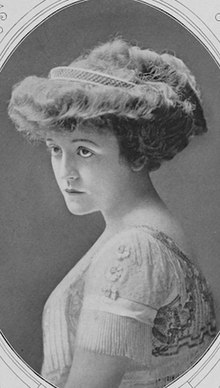Mabel Frenyear was an American actress and chorus girl.
Mabel Frenyear | |
|---|---|
 Frenyear, from a 1909 publication | |
| Born | August 25, 1880 Brooklyn, New York City, New York, U.S. |
| Died | unknown |
| Occupation(s) | Actress, chorus girl |
| Spouses | Edward F. Dunn
(m. 1900; div. 1904)
|
Early life and career
editMabel Frenyear was born on August 25, 1880, the daughter of Edward L. Frenyear and Eva Tollman.[1][unreliable source?]
She began her career in Broadway theatre, appearing in plays such as The Girl in the Barracks (1899),[2] The Stronger Sex (1908–1909), The Only Law (1909),[3][4][5] Where There's a Will (1910), You Can Never Tell (1915), The Importance of Being Earnest (1921),[6] and Montmartre (1922).[7] She also appeared in productions of The Wizard of Oz,[8] Babes in Toyland, Father and the Boys (1910),[9] The 'Mind-the-Paint' Girl (1912),[10][11] Nothing But the Truth (1916),[12] and Kissing Time (1921).[13]
Frenyear took chorus roles to prepare for her role as a chorus girl in The Only Law.[14] A Minnesota reviewer in 1921 noted that Frenyear was "really pretty and plays her part with spirit."[15] Her stage work was not always so admired; "If Miss Frenyear would not shriek her lines unintelligibly," commented one reviewer in 1915, "the worst defect of the production would be removed."[16]
In addition to being a stage actress, Frenyear appeared in three silent films; A Fool There Was (1915), a Theda Bara vehicle,[17] Tit for Tat (1915), a comedy,[18] and Social Quicksands (1918),[19] written by Katharine Kavanaugh. On her first trip to make films in Los Angeles in 1914, she made headlines for criticizing local women's fashion. "Southern California is a wonderland to me, but the women in Los Angeles; oh, they dress so terribly," she declared.[20]
Personal life
editFrenyear married three times. On February 17, 1900, she married Edward F. Dunn.[21] She only lived with Dunn for eight weeks, when he sold all her jewelry and gambled the proceeds; they divorced in 1904.[8] On December 22, 1904, she married Thomas R. Finucane in Chicago, Illinois.[22][unreliable source?] Their marriage was almost immediately annulled because both parties admitted they were "married while intoxicated".[11] In 1911, she was rumored to have married her co-star, Ralph Kellard, but both "laughed at the mere idea".[23] And on April 27, 1940, she married her third husband, Harry Young, in Chicago. Her date of death is unknown.
References
edit- ^ "Register". Ancestry.com. Retrieved September 26, 2023.
- ^ The Play: Published Weekly in the Interests of the Theatre and Amusement-going Public. 1900.
- ^ White, NY (1909). "Miss Mabel Frenyear in "The Only Law"". The American Vaudeville Archive — Special Collections, University of Arizona Libraries. Retrieved May 4, 2020.
- ^ Pollock, Channing (October 1909). "Unmuzzling the Theatrical Season". The Green Book Magazine. 2: 777–778. ISBN 9781476604848.
- ^ Nathan, George Jean (December 1909). "Players and the Plays". The Burr McIntosh Monthly. 21.
- ^ Mantle, Burns; Chapman, John Arthur; Sherwood, Garrison P.; Kronenberger, Louis (1921). Burns Mantle Yearbook. Dodd, Mead. pp. 422.
- ^ Kinder, Larry Sean (January 29, 2016). Una Merkel: The Actress with Sassy Wit and Southern Charm. BearManor Media. p. 360.
- ^ a b "Mabel Frenyear Dunn is Granted a Divorce". The Topeka Daily Capital. July 23, 1904. p. 2. Retrieved May 4, 2020 – via Newspapers.com.
- ^ "Miss Frenyear Makes a Hit in 'Father and the Boys'". The Buffalo Times. November 18, 1910. p. 3. Retrieved May 4, 2020 – via Newspapers.com.
- ^ "The New Plays". The Theatre Magazine. 16: 98. October 1912.
- ^ a b "Admits Wine Made Wedding". Chicago Tribune. via Newspapers.com. January 4, 1909. p. 9. Retrieved May 4, 2020.
{{cite web}}: CS1 maint: others (link) - ^ "Mable Frenyear in 'Truth'". Variety. 43: 1. June 2, 1916.
- ^ "Kissing Time". Altoona Tribune. November 24, 1921. p. 10. Retrieved May 4, 2020 – via Newspapers.com.
- ^ "Studied Chorus Girls". The Washington Post. October 3, 1909. p. 2. Retrieved May 4, 2020 – via Newspapers.com.
- ^ Lenart, Elta (October 17, 1921). "Amusements". Star Tribune. p. 6. Retrieved May 4, 2020 – via Newspapers.com.
- ^ "Plays and Players". Brooklyn Life. 51: 16. April 17, 1915.
- ^ Klepper, Robert K. (September 16, 2015). Silent Films, 1877–1996: A Critical Guide to 646 Movies. McFarland. p. 62. ISBN 978-1-4766-0484-8.
- ^ "Pastime Airdome". Abilene Daily Chronicle. July 2, 1915. p. 1. Retrieved May 4, 2020 – via Newspapers.com.
- ^ "Amusements". Wairarapa Age. November 10, 1919. p. 3. Retrieved May 4, 2020 – via Papers Past.
- ^ "Women of Los Angeles Are Out of Style; Criticism Made by Actress Mabel Frenyear". Los Angeles Evening Express. May 25, 1914. p. 11. Retrieved May 4, 2020 – via Newspapers.com.
- ^ "Ancestry – Sign Up". www.ancestry.com.
- ^ "Register". www.ancestry.com. Retrieved September 26, 2023.
- ^ "Are Not Married". Syracuse Herald. August 2, 1911. p. 3 – via NewspaperArchive.com.
External links
edit- Mabel Frenyear at IMDb
- Mabel Frenyear at the Internet Broadway Database
- Mabel Frenyear at Playbill Vault
- Three photographs of Mabel Frenyear, in the Billy Rose Theatre Collection Photograph File at the New York Public Library Digital Collections.
- A Fool There Was (1915), silent film featuring Mabel Frenyear, on Internet Archive.